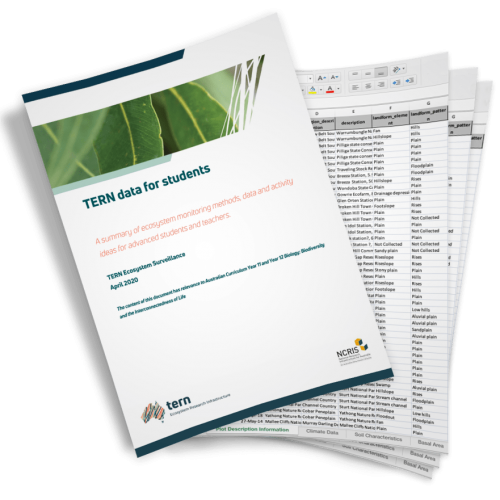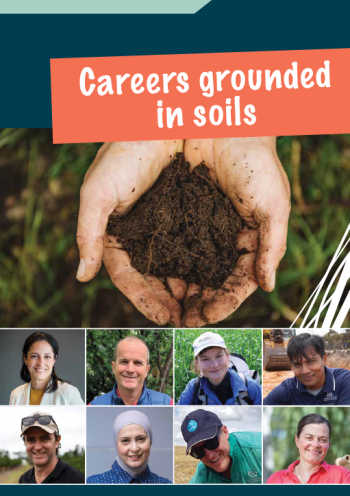Educational resources
Whilst not collected and developed primarily as ecology teaching resources, TERN’s data and description of the methods and equipment used are naturally suited to being applied in teaching concepts and skills related to the Australian environment.
These environmental science teaching resources are useful in the delivery of high-quality education in both online and regular teaching environments. They are particularly useful as an alternative to field-based data collection.
If you have any questions or feedback, please contact us. Also, if you have teaching materials developed using TERN data or resources, we’d love to help you share them with other instructors interested in using TERN data as ecology teaching resources.

Careers Grounded in Soils
This publication was endorsed by the National Soils Advocate, The Hon. Penny Wensley AC, on the 8th of December 2022 during the launch of the TERN Australia Soil & Herbarium Collection at the University of Adelaide’s Waite Campus.
The publication contains the results of 33 interviews with people who, in 2022, have jobs relevant to soils. It is intended for use by secondary and tertiary students who are perhaps wondering what to study or which career might be satisfying – or maybe they have already chosen a
soils-related career and are keen to learn something about others who they may meet as lecturers, coworkers or employers.
The booklet will also hopefully be a useful resource for those that assist students with such decisions, including teachers, careers counsellors, guidance officers, librarians, and parents.

To download a pdf click on the SlideShare logo at the bottom right corner of the viewer then the blue download button on the SlideShare page. Please help promote the value of soil science by sharing with colleagues and partner organisations.
Get started using TERN’s ecosystem data
Now that TERN has assembled data into an easily downloaded spreadsheet, teachers and students have access to large, authentic, environmentally-related data sets—including data from more than 700 TERN Ecosystem Surveillance monitoring plots.
The data in the Excel spreadsheets provide quick and easy access, all without requiring complex data processing tools, such as R Studio. An accompanying summary document provides information and explanation to help you get started using the TERN datasets as ecology teaching resources.
You can use these environmental science teaching resources to help gain an insight into scientist-collected data, and to analyse and understand Australian ‘big data’, open-source data, field methods, statistics, and habitat variables.
Usefully, the document has a number of ideas and suggestions on how students can utilise the data available.
TERN ausplotsR tutorial
Tutorial 1: Retrieving and Filtering Data
Get started with TERN’s ausplotsR package using our introductory tutorial video. Access and filter soil and vegetation data collected at >800 environmental monitoring sites across a range of Australian bioregions and vegetation communities. Users can also search for information on TERN’s soil and plant samples.
Educational activities at TERN sites
Modern teaching and conference facilities suitable for university and school group activities are available at a number of TERN Ecosystem Processes SuperSites. Some sites also offer an education facilitator to enhance students’ learning experiences and a number of pre-prepared curriculum-linked ecology teaching resources are available for teachers.
TERN sites regularly host students and teachers from Australia and overseas, with activities ranging from environmental education tours with primary school students through to secondary school and undergraduate field trips and internships. Many community organisations are also actively involved in conservation and rehabilitation activities at TERN sites.
For example, Credo Station, within TERN’s Great Western Woodlands SuperSite in Western Australia, has a multi-purpose field studies centre for educators and scientists. Similar facilities are available at TERN’s Calperum Mallee SuperSite in South Australia, Samford Peri-urban SuperSite in Queensland, and Cumberland Plain SuperSite in New South Wales.
At the Tahune Airwalk, within TERN’s Warra Tall Eucalypt SuperSite in Tasmania, an interpretive centre provides data and research information from the SuperSite to public visitors and school groups.
In Far North Queensland, James Cook University’s Daintree Rainforest Observatory is collocated at TERN’s affiliate Daintree Rainforest SuperSite to provide facilities for educators, researchers and students.
In the Northern Territory, a number of Charles Darwin University courses use the research infrastructure at TERN’s Litchfield Savanna SuperSite to train undergraduate and postgraduate students in remote-sensing techniques. Students are taught the same field data sampling techniques as those used by TERN researchers, enabling the students to play a role much greater than simply collecting data needed for their studies. Because students use standard methods on permanent transects, the data can be added to the SuperSite’s long-term data collection.
Community groups are also active at TERN SuperSites. At the TERN Wombat Stringybark Eucalypt SuperSite, community groups including the Wombat Forestcare Inc, the Victorian National Parks Association and the Whroo Goldfields Conservation Management Network use the site for education and outreach activities.






